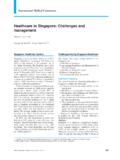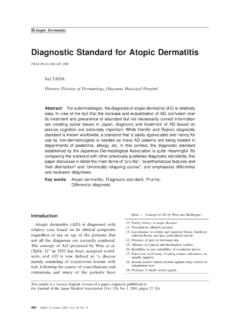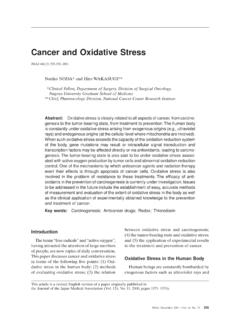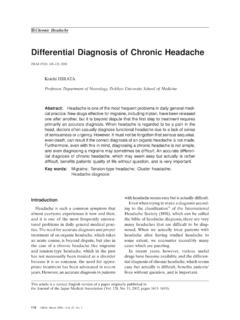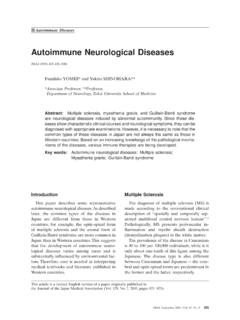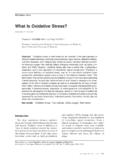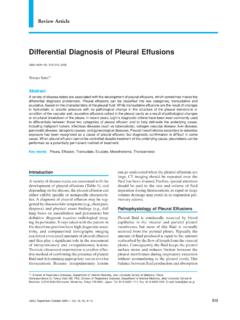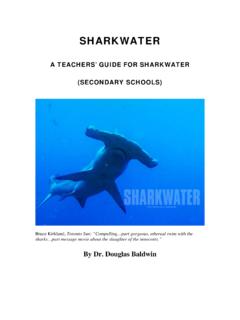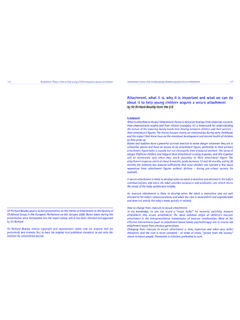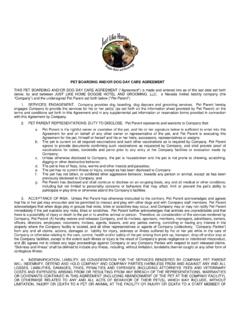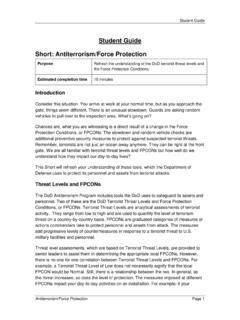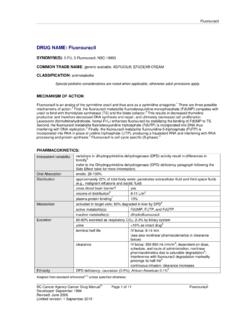Transcription of Causes of Falls in the Elderly - Med
1 JMAJ, July 2001 Vol. 44, No. 7299 Causes of Falls in the ElderlyJMAJ 44(7): 299 305, 2001 Fumio ETOP rofessor, Department of Rehabilitation Medicine,University of Tokyo HospitalAbstract: Falls are commonly encountered in daily life. Many of them are treatedas accidents and are called accidental Falls . Factors associated with repeated fallingcan be divided into intrinsic and extrinsic types, but several factors are usually involvedin causing a fall . To identify the Causes , the circumstance under which the fall occurredshould be clarified in detail. Falls tend to occur when rising from and sitting in a chair,but also while walking on flat ground or a floor. Persons who are more likely to falloften have disabilities like hemiplegia, muscle weakness, parkinsonism, or ataxia, orelse have cognitive impairment. Medications are another risk factor for falling.
2 Par-ticular caution must be exercised in patients who are taking hypnotics or tranquiliz-ers. The majority of Elderly persons fail to remember the details of a fall , so theseshould be clarified by information from members of the family or other intrinsic factors must be treated to prevent the recurrence of falling, it isalso important to examine and improve the living words:Accidental fall ; Post- fall syndrome; House-bound; RehabilitationIntroductionFalls are common events in daily life andmany of them can be considered occurrence of Falls increases in the Sheldon (1960) reported Falls in the eld-erly,1) many studies on the cause of these eventshave been performed. Current investigationson Falls are based on the view that the factorspredisposing to repeated Falls can be dividedinto two categories, intrinsic and extrinsic, withmultiple factors often being )This article is a revised English version of a paper originally published inthe Journal of the Japan Medical Association (Vol.
3 122, No. 13, 1999, pages 1950 1954).The Japanese text is a transcript of a lecture originally aired on August 24, 1999, by the Nihon ShortwaveBroadcasting Co., Ltd., in its regular program Special Course in Medicine .What Are Falls ?A fall occurs when a person who is standingslips from an upright position and comes intocontact with the ground. The person who fallsmay also contact the ground with a part of thebody other than the feet instead of lying full-length on the ground. A fall onto the buttocksor knees can be also considered as a fall . Theseevents are all regarded as Falls in the Interna-tional Classification of Disease (ICD) publishedby the WHO. There are two types of Falls . One Medical Care for the Elderly300 JMAJ, July 2001 Vol. 44, No. 7F. E T OTable 1 International Classification of Falls (ICD-10)
4 Falls codeW00 fall on same level involving ice and snowW01 fall on same level from slipping, tripping and stumblingW02 fall involving ice-skates, skis, roller-skates or skateboardsW03 Other fall on same level due to collision with, or pushing by, another personW04 fall while being carried or supported by other personsW05 fall involving wheelchairW06 fall involving bedW07 fall involving chairW08 fall involving other furnitureW09 fall involving playground equipmentW10 fall on and from stairs and stepsW11 fall on and from ladderW12 fall on and from scaffoldingW13 fall from, out of or through building or structureW14 fall from treeW15 fall from cliffW16 Diving or jumping into water causing injury other than drowning or submersionW17 Other fall from one level to anotherW18 Other fall on same levelW19 Unspecified fall *Excludes: assault; fall (in) (out): animal, burning building, into fire, into water, machinery (in operation), transport vehicle;intentional self-harmPlace of occurrence code.
5 0 Home. 1 Residential institution: Children s home, dormitory, home for the sick, hospice, military camp, nursing home,old people s home, orphanage, 2 School, other institution and public administrative area. 3 Sports and athletic area. 4 Street and highway. 5 Trade and service area: Airport, bank, caf , casino, garage (commercial), gas station, hotel, market, office building,petrol station, radio or television station, restaurant, shop (commercial), station (bus) (railway), store, supermarket, 6 Industrial and construction area. 7 Farm. 8 Other specified places: Beach, campsite, canal, caravan site NOS, derelict house, desert, dock NOS, forest, harbour, hill,lake, marsh, military training ground, mountain, park pond or pool, prairie, railway line, river, sea, seashore, zoo, 9 Unspecified placeActivity code. 0 While engaged in sports activity: Golf, jogging, riding, skiing, swimming, trekking, 1 While engaged in leisure activityExcludes: Sports activities.
6 2 While working for income. 3 While engaged in other types of work: Domestic duties such as caring for children and relatives, cleaning, cooking,gardening, household maintenance. 4 While resting, sleeping, eating or engaging in other vital activities. 8 While engaged in other specified activities. 9 During unspecified activitySource: International Statistical Classification of Diseases and Related Health Problems. 10th Revision, WHO, , July 2001 Vol. 44, No. 7301the subjects may find it difficult to rememberall of the Falls that they have experienced. Con-sequently, the incidence of Falls is likely to beunderestimated. Accurate memories of fallsby subjects are essential for retrospective sur-veys. To ensure accuracy, Falls from standingare often defined as those in which the personlying on the ground or floor after falling mustraise the body using the knees or buttocks toreach the upright position.
7 In prospective stud-ies, however, this problem is less serious. Insome of them, particularly studies performedin Japan, Falls leading to contact of part of thebody other than the feet with the ground arealso partly covered because of the difference inmeaning between the English term fall andthe Japanese counterpart. In Japan, a fall fromone level to another is usually distinguishedfrom a fall to the ground. In studies on post-fallsyndrome5) and premonitory Falls , Falls are de-fined as events in which persons who have fallenneed to move or need help to raise the bodyfrom the ground or floor regardless whetherthere are complications or )In many studies, about 30% of persons overthe age of 65 who live in the community havebeen estimated to fall at least once a year. Theincidence calculated at hospitals and institu-tions is difficult to compare because of the di-versity of samples, which vary depending onthe type of institutions and the circumstancesunder which hospitalization and discharge Factors for FallsCauses that make Falls recurrent are summa-rized in Fig.
8 1. Because falling usually occursunintentionally, it is called an accidental Causes usually combine to produce a Causes can be divided into two categories,intrinsic and extrinsic. Intrinsic factors includedisease and physical symptoms, whereas extrinsicfactors are environmental. To identify the fac-tors responsible for a fall , it is essential to definethe circumstances under which the fall has oc-curred in detail by interview. A fall occurs wheninvolves a series of movements in which theupper body descends from a standing positionto the ground. In the other type, the whole bodyfalls from one level to another. In Japanese,two different words Tento and Rakka areused to express these respective types of listed in ICD-10 for epidemiological stud-ies include those from a bed or chair (Table 1).3) Falls are not only one of the major Causes ofdeath in the Elderly , but also result in a markedreduction of daily activities secondary to a de-creased ability to walk or move and hence de-terioration of the quality of life.
9 Consequently, Falls are recognized to be important interna-tionally and are studied Falls are accidental. It has been reportedthat mortality is increased among Elderly indi-viduals who have fallen, even without a frac-ture occurring. Moreover, Falls can lead to physi-cal dysfunction, disability, and social disadvan-tage. The fear of falling again and the onset ofunsteadiness when standing or walking can leadto confinement in a narrow sphere of living,where the Elderly become largely inactive in-stead of continuing their former daily the Elderly , unexpected accidents such asfalls are an important cause of death. More-over, serious diseases such as myocardial infarc-tion, pneumonia, and malignancy are often de-tected during hospitalization after a fall (pre-monitory fall ).4)In Japan, bedridden Elderly persons remaina major medical and social problem.
10 The greatestattention should be directed to falling, becauseit is one of the direct Causes of Elderly personsbecoming cope with Falls , it is essential to clarify thecharacteristics of persons who have fallen pre-viously and to identify risk factors. Persons whohave fallen are defined variously in differentstudies. Epidemiological surveys on Falls haveusually been performed in persons who fell dur-ing the previous three, six, or twelve are common events, except when compli-cated with a fracture or wound that requiresprolonged treatment. In retrospective studies, Causes OF Falls IN THE ELDERLY302 JMAJ, July 2001 Vol. 44, No. 7a person moves and departs from the optimumposition unexpectedly and fails to correct theirposture by the righting reflex. The fall may becomplicated by a fracture depending on theextent and nature of the defense reflex that in which Falls may occur are asfollows: 1) A fall may take place without exter-nal force while the victim is performing a usualmovement, sitting in and arising from a chair orwalking on flat ground, for example.
